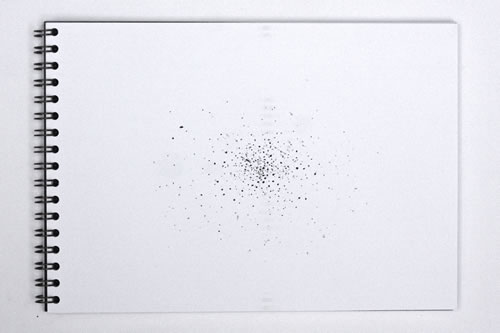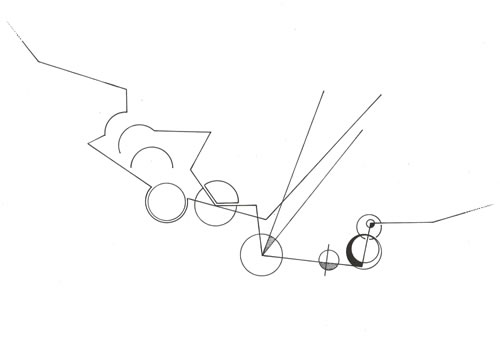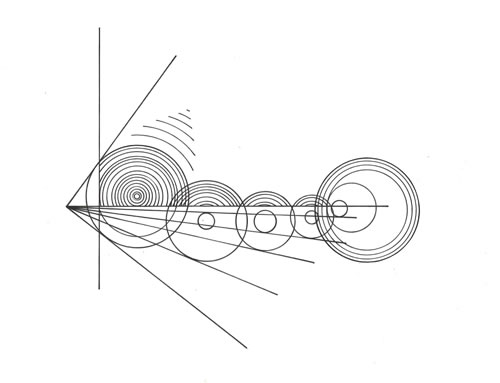FRAMEWORK
Interpretation of graphic scores using a small modular system
The FRAMEWORK project consists of 14 hand-drawn graphic scores and a recording for each score. After several hundred sketches for graphics and audio made during 2013, I was able to finish and release the project in December 2014 on the arbitrary publishing platform in a book+CD format, containing my own recordings and interpretations by other artists such as Andrea Neumann (Germany), Adam Pultz Melbye (Denmark) and others. 1[1. See the arbitrary website for more information on FRAMEWORK and other arbitrary releases.] The scores were finished first — early sketches included very specific information on sound sources, frequency, time and duration.

To keep the following recording process open and still provide some direction, I decided to include only these simple instructions:
These 14 graphic scores may be played by any configuration of instruments and players — the recordings may be of any duration. Some of the scores are linear and may be read from left to right; others are meant as a conceptual inspiration for composition and performance. The balance between these two approaches is to be decided by the interpreter.
A circle should be seen as a space, room or atmosphere. A line illustrates direction / time, and possibly a sustained tone. Smaller dots or points may be read as dust, drops, texture or granulation. An incomplete circle or square marked with an arrow signifies a loop / repetition, which consists of certain elements, if notated.

The scores are in the form of black lines on white paper, visually and conceptually inspired by Cornelius Cardew’s Treatise, works found in John Cage’s Notations, scores / almost technical drawings by Karlheinz Stockhausen, Else Marie Pade (Denmark) and Iannis Xenakis, as well as works by Russian suprematist artists and various architectural drawings. While researching and taking inspiration from these constructivists, suprematists, etc., I was also fascinated by the idea of working with sounds that are not attached to any specific narrative, and being concerned only with the actual sounds themselves, the graphics found in the scores and the interaction between the two.

For the original drawings, I chose to work with manifold paper — semi-transparent and thinner than tracing paper, often used by architects for sketching and overlaying multiple drawings. In this way, I could work with “filtering” / blurring, shadows and overlaying very early in the process, all of which gave directions in terms of room, depth, volume and tone, and thus were inspiring for the performances found on the audio recordings. For instance, FRAMEWORK #1 plays with depth, presence and stereo field (Fig. 2, Audio 2), whereas in FRAMEWORK #12, a texture of granulated sounds and white noise is hidden behind similar sounds that are louder and punctuated. The pitch of the 8-step sequence was programmed according to the dots and lines placed around the first large circle (Fig. 3, Audio 3).
In FRAMEWORK #3, the attempt was to make a chaotic and sharp sounding yet somehow “blurred” stepped random sequence and collection of metallic sounds grow out of a warmer, vibrating loop; this is represented in the score in both the graphic images used and the differences in layering and opacity (Fig. 4, Audio 4).

Paper, Print and Sound Sources
Very early on, I saw a strong connection between, on the one hand, the graphics, visual structures and working in the format of pen and paper (the final print being the conqueror: thick aquarelle paper), and, on the other, analogue sound sources, and I decided to record all sounds from a small, modular synthesizer. In this case, a range of sources was used for all of the 14 recordings: white and pink noise, (often randomly sequenced), sine / triangle waves, amplified hum / spring reverb and cable noise. A few recordings and loops of cymbal overtones were added, as well as some granulations and samples of these sources, made using two digital modules and treated with a bit of post-production. Furthermore, I found a basic, direct similarity between drawing, combining shapes, circles, dots etc. and programming the synthesizer with patch cables and combining different modules — both in terms of interaction, or the “conversations” between each, and linearity, structure and time — as well as the process of recording and editing, cropping and automating, as I’m very visually oriented when it comes to planning and producing.

For me, the substance of the actual sounds, the architectural quality and the tactility — the feeling of actually placing sounds and touching each sound coming from the speakers, which I was able to produce in this format of pure electricity — is very similar to the feel of shapes, circles and dots drawn by hand and being printed on thick paper. The sparse use of digital effects gave a twist to these classic sounds, as an attempt to add somehow colder, “modern”-sounding elements, and it turned out to be connected with the feel of the final print. As the book was printed with Risograph, a digital printing system, subtle glitches and some sort of a digital translation of the original drawings are visible. Doing the initial test prints and deciding to work with this printing method inspired me to go for, and emphasize, this “second voice” of computer sounds, along with the purely analogue sound recordings. The modules chosen for this are quite idiosyncratic and unreliable — Mungo g0 and an ADDAC .Wav Player — and these were patched to create some of the short and more playful, automatic / generative pieces, such as FRAMEWORK #4, #5, #8, #9, #10. In #10, the Wav Player reacts to a series of notes, playing back short files or snippets of white noise, repeated and granulated (along with the notes/sequence) by the much cleaner sounding g0 (Fig. 5, Audio 5).

Surprises and mistakes in the drawing process turned out to be very similar to working with the modular system — and particularly this combination of file playback and granulations — as when the pen and ruler skip while working on sketch or version nr. 30. Such “errors” could often turn to be quite useful and inspire one to change the drawing, resize and work with different proportions, combine new elements, etc. In a more direct way, the noise/hum loop on #3 came out of a bad cable connection, and #4 and #14 include a quite heavy amplification of tape hiss, spring reverb noise and file-playing glitches.
The sounds on the recording for FRAMEWORK #6 somehow follow the structure of circles, but the recording was mainly inspired by the drawing in a more indirect way — to replicate the look of antennas or a space station (Fig. 6, Audio 6).
Scores and Future
In many cases, when finishing the recordings, I was surprised about what came out of working with the visual material. To me, this is exactly what makes the specific media and format interesting to work with. The lines, symbols, circles give me a (more or less clear) direction and specific starting points, but due to the sparse instructions given, even I feel constantly surprised by the results. This applies to both live and recording situations.
I’ve decided to continue with the project / concept as a series of releases, containing prints and music — with various collaborators, setups and constellations. A second release (FRAMEWORK II) is currently being planned. This will include scores that are more fragmented or collage-like than in the original series, with multiple layers and possibly using different colours, and recordings with a range of acoustic instruments (strings, others), to be transformed and combined with electronic processing and/or sound sources.
Social top